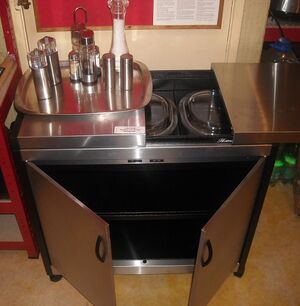Hostess Trolley


Introduction
When I was a child, there were four cooking related items that my grandmother had and that my mother did not. I vowed that one day I would own all four of these items: two books, Larousse Gastronomique and The Constance Spry Cookery Book, a Kenwood Chef and a Hostess Trolley. My grandmother gave me a copy of Larousse for a birthday present back in the 70s, I managed to find a second-hand copy of Constance Spry in a charity shop a couple of years ago, I bought a Kenwood Chef in January 2011 and finally, in November this year, I was delighted to take delivery of my Hostess Trolley. Mission accomplished!
How frightfully 70s, you may well be thinking and indeed Cookipedia's founder, Chef, sent a reply to me with mutterings of Abigail's Party when I told him I had ordered one. Well, 70s they may be, but they are still just as useful in the home today, as they were 40 years ago.
What are they?
If you are too young to remember them then let me explain. Basically it is a heating cabinet for food, and it keeps hot food hot. It is not designed for heating food from cold. They all have a top compartment containing 3 removable pyrex dishes with lids, but if preferred you can also use your own dishes in there. Underneath the top compartment you have a choice of one or two heated shelves. The ones which have just one heated shelf have a plain, open shelf underneath.
Every Hostess Trolley is on castors for easy movement from your kitchen to your dining table, if you wish to serve straight from it. Otherwise you can just bring the dishes in from the kitchen and place them on the table. Naturally you can also use it as a plate warmer. You can keep food hot for several hours, but make sure that you use covered dishes only or the food will dry up. Operation is easy - just plug it in. The instructions say that you should switch on for 20 minutes before use, but I find it does need a little longer, say 30-35 minutes. It is advisable to add any dishes and plates that you want to use at the same time as you plug it in to avoid the possibility of them cracking due to sudden heat.
When would you need to use it?
Traditionally, they were used for dinner parties, but they are also ideal for Sunday lunch, family meals, takeaways, buffets, barbecues and breakfasts. They are ideal for the busy modern family enabling you to cook once and have food available as family members come in and out. If I am in a hurry when making bread, or the kitchen is too cold, I switch it on and place the bowl of dough on the top to help it rise. Never put dough inside the trolley when it is on though, as it is too hot and will kill the yeast.
Materials and price
The most common material that the Hostess Trolley is made from is imitation wood and there is a wide choice of finishes. However, they are now available in brushed steel or real wood veneer. Prices range from £199 - £745 (December 2011)
Who makes them
Unusually, they are still manufactured in Britain, in Halifax, to be precise, by a company called Crosslee Plc. If my corporate genealogy is correct, the Hostess Trolley was originally made by a company called EKCO who were taken over by Philips in 1967. In 1988 Phillips went into a joint venture with Whirlpool called Whirlpool International selling Philips' domestic appliances. In 1991, Whirlpool bought Philips out and manufacture of the trolleys was transferred to Crosslee, a Whirlpool subsidiary.
See also: Chafing dish